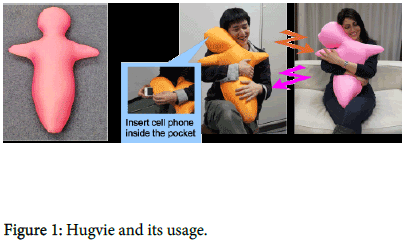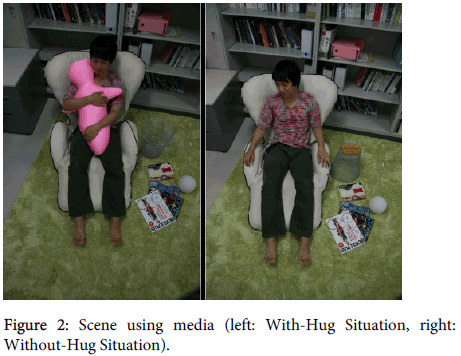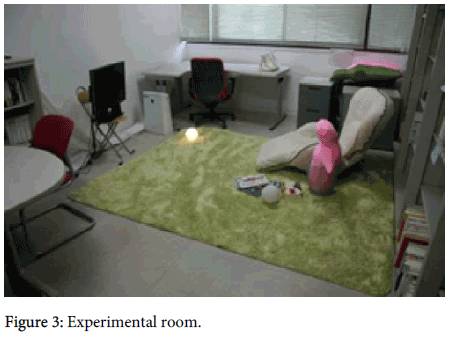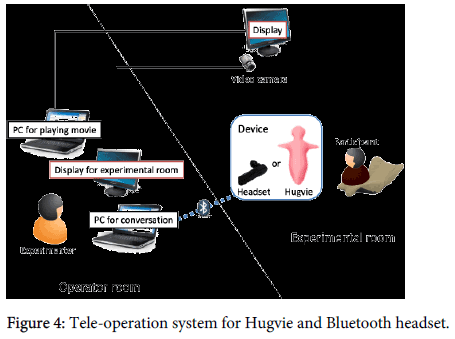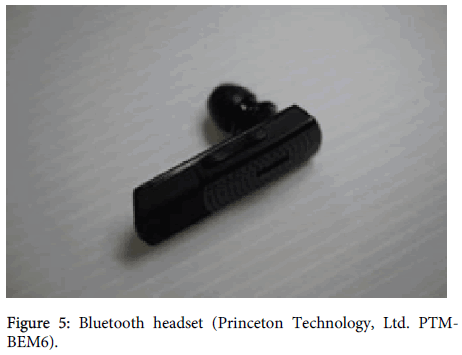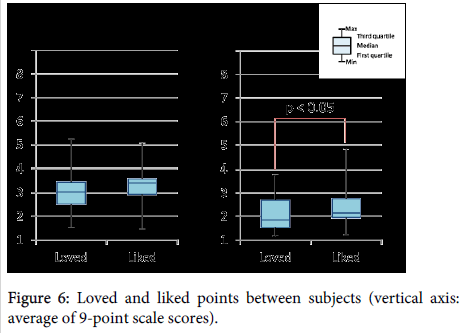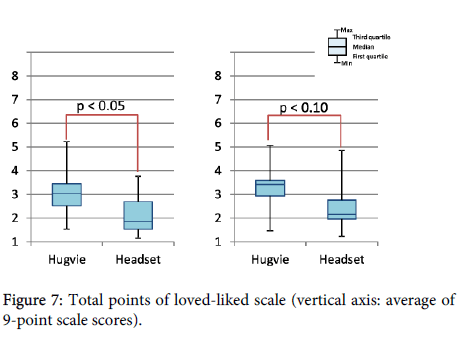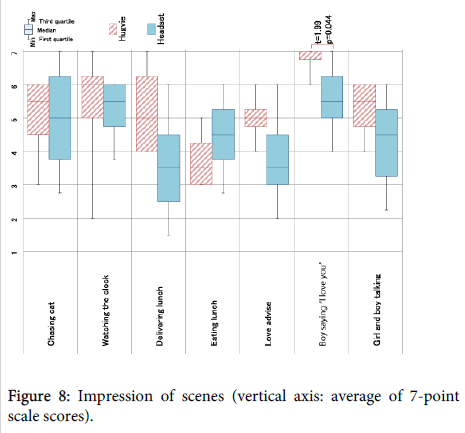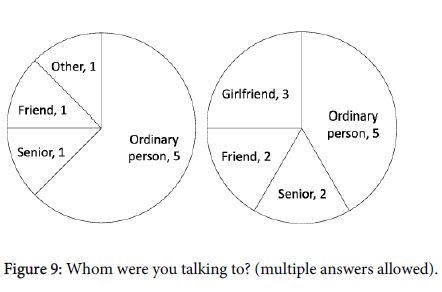Research Article Open Access
Hugvie: Communication Device for Encouraging Good Relationship through the Act of Hugging
Kaiko Kuwamura1,2*, Kurima Sakai1,2, Takashi Minato2, Shuichi Nishio2 and Hiroshi Ishiguro1,2
1Graduate School of Engineering Science, Osaka University Machikaneyamacho 1-3, Toyonakashi, Osaka, Japan
2Hiroshi Ishiguro Laboratory, Advanced Telecommunications Research Institute International (ATR) 2-2-2 Hikaridai, Keihanna Science City, Kyoto, Japan
- *Corresponding Author:
- Kaiko Kuwamura
Hiroshi Ishiguro Laboratory
Advanced Telecommunications Research Institute International (ATR)
2-2-2 Hikaridai, Keihanna Science City, Kyoto 619-0288, Japan
Tel: +81 774 95 1560
Fax: +81 774 95 1408
E-mail: kaikou.kuwamura@atr.jp
Received date: January 06, 2014; Accepted date: February 01, 2014; Published date: February 09, 2014
Citation: Kaiko Kuwamura, Kurima Sakai, Takashi Minato, Shuichi Nishio and Hiroshi Ishiguro (2014) Hugvie: Communication Device for Encouraging Good Relationship through the Act of Hugging. Lovotics 1:104. doi:10.4172/2090-9888.10000104
Copyright: © KaikoKuwamura, et al. 2014. This is an open-access article distributed under the terms of the Creative Commons Attribution License, which permits unrestricted use, distribution, and reproduction in any medium, provided the original author and source are credited.
Visit for more related articles at Lovotics
Abstract
In this paper, we introduce a communication device which encourages users to establish a good relationship with others. We designed the device so that it allows users to virtually hug the person in the remote site through the medium. In this paper, we report that when a participant talks to his communication partner during their rest encounter while hugging the communication medium, he mistakenly feels as if they are establishing a good relationship and that he is being loved rather than just being liked. From this result, we discuss Active Co-Presence, a new method to enhance co-presence of people in remote through active behavior
Keywords
Hug; Co-presence; Telecommunication character count (including spaces): 23032
Introduction
In this paper, we introduce a communication medium which triggers user to establish a good relationship with others through the medium. We designed the communication medium Hughie which users have to hug to use (Figure 1). Hugvie is a communication device with a cushion which users have to hug it to communicate with others. Although Hugvie only transmits users' voice, by hugging it, user will have enhanced feeling of the counterpart in remote location and at the same time, users will complete positively information that is lacking by the narrow bandwidth of the device.
In daily life, we often complete information that is lacking. For example, when you ask some question to a customer centre staff and if her voice is nice and she responds so kind to you, you may imagine her as a nice person. Although you are talking through a cell phone and it only transmits voice, you might imagine an appearance of a gentle lady in your mind. You do not know her appearance and personality. However, you completed the appearance and personality positively from the information (nice voice and kind reaction) transmitted from the cell phone.
In this case, person who called the customer centre completed the lack of information (appearance and personality) positively from the factors (nice voice and kind reaction) which he received passively. However, our hypothesis is that such factors can also be generated actively, instead of just passively perceiving received information. One way to make it, we think, is to hug the speaker virtually through the communication medium. If the user hugs it, instead of just holding it at his ear or facing the device, the user may feel like hugging the person in remote and feel enhanced presence of the person. We believe that the lack of the information transmitted through the communication media can be completed and enhanced by actively behave or imagine toward the communication media. Here, the speaker can limit factors which give negative impression and transmit the factors which trigger to impress positively to improve the impression of the speaker. This method is similar to make-up, which changes your appearance to improve the impression. Both give better impression toward the opponent and help constructing better relationship.
In this paper, we compared Hugvie, a device you have to hug to communicate, and a headset, which you do not need to hug to communicate. We examined whether the behavior of hug complete the lack of information positively and enhance speaker's presence. We describe the details of the experiment and we show the results. Based on the results, we further discuss about the possibility to enhance co-presence of remote person by devices that induce users' active behavior.
Related Works
Kellerman reported that the gazing behaviour of people in relationships toward strangers of the opposite sex increased feelings of passion for each other [1]. We believe that feelings of love are also increased by communication devices that represent a partner and interacting affective behavior toward the device. We focused on hugging behaviors to support the establishment of feelings of affection.
Many devices support lovers and transmit presence. Adcock et al. [2] invented a belt to support the interaction of couples who are apart. Mueller et al. [3] invented a coat that transmitted the feeling of being hugged remotely. Many media transmit the feeling of being hugged and resemble counseling from remote places [4-6]. These are used when lovers cannot meet and address loneliness. However, such devices are designed for those who already have formed good relationships. The problem we are facing is that some people have trouble talking to others. They need a device that supports opportunities to feel affection.
Nishimura et al. [7] used vibrations to simulate a heartbeat on the chests of participants and controlled the frequency of false heartbeats. They verified that a preference toward female nude photos increased by modulating the frequency of false heartbeat. When such the misattribution of arousal happened, the increased heartbeat may be recognized in the participant's mind as due to the affection toward the female in the photo. Valins artificially changed the feedback of one's heartbeat and moved one's emotion [8]. Such studies control emotions by giving artificial stimulus. We believe that unconsciously doing affective behaviors toward a communication device, which represents one's partner, also enables users to feel affection.
Dutton and Aron [9] studied one's affection mistakenly evoked. In their experiment, male participants were contacted either on a fear-arousing suspension bridge or a non-fear-arousing bridge by an attractive female or a male interviewer who asked them to all out questionnaires containing Thematic Apperception Test (TAT) pictures [10]. The sexual content of the stories written by participants on the fear-arousing bridge and their tendency to attempt post experimental contact with the interviewer were both significantly greater. No significant differences between bridges were obtained on either measure for participants who were contacted by a male interviewer. These results suggest that misattribution occurred and that the participants on the fear-arousing bridge established felt affection toward the female interviewer. Here, the misattribution of arousal means a mistake in explaining the aroused feelings [11]. Hugvie is designed to virtually hug the speaker to enhance the presence. That is, Hugvie is designed to create misattribution of behavior hugs.
Methods
Outline
To reveal the effect of the hug behaviors, we arranged with-hug and without-hug situations. We compared the former with Hugvie and the latter with a Bluetooth headset to verify our hypothesis (Figure 2).
The participants were limited to males, like Dutton and Aron's experiment [9]. We focused on active affection, defined as affection toward the female and passive affection, defined as the affection the participants thought they received. To measure the effect of the hugs, we controlled and ignored the in influence of the conversation contents as much as possible. We recorded the female voices to establish conversations with the male participants to control the conversation between the subjects.
We created a relaxed environment in the experimental room by placing magazines and a legless chair on the rug with indirect lightning and arranged and operator's room outside of the experimental room (Figure 3).
The participants were told that the female was in an identical environment in a different room. Since we used a single medium (Hugvie or Bluetooth headset) on each participant, we compared the medium between participants (Figure 4).
Apparatus
We compared the with-hug situation using Hugvie and the without-hug situation using a Bluetooth headset (Figure 5). Hugvie is a huggable pillow resembles a human with a pocket on its head where user places his cell phone or similar devices to listen to the interlocutor's voice. Hugvie has flexibility texture filled with micro beads, and the following are its specifications:
Size: height 800 width 550 depth 200 (mm); Weight: approximate 600 g (device included).
Procedure
We conducted our experiment as follows:
The participants talked for three minutes with male experimenters through one medium (Hugvie or Bluetooth headset) to get used to it. Conversation topics included current events to suggest that the conversations were live and not recorded.
The participants waited in the experimental room for ten minutes. While waiting, they got used to the experimental room by flipping through magazines, but they were not allowed to use their cell phones or other electronic devices.
They got call from the medium and rest introduced themselves for around 30 to 60 seconds to the female experimenter, whose voice was recorded. To prevent the participants from noticing that the experimenter's voice is recorded, they are prohibited from questioning their female interlocutor due to privacy concerns. The female experimenter introduces herself rest and lets the participant introduce himself next to begin the conversation. The moment to play the female experimenter's voice was decided by the experimenter who was listening to the participant.
After their introduction, the participants watch the movie for 30 minutes with the medium who remains on the cell phone.
The experimenter tells the participants to disconnect the medium. Then the experimenter tells them to wait briefly while the next experiment is being prepared. The participants are also given permission to call their female conversation partner using the medium.
After the participants call their female conversation partner or do not call for 15 minutes, the participants answer questionnaires and are interviewed.
Conversation while watching the movie was also discouraged so that they could concentrate on the movie. Only one participant noticed that the voice is recorded; he was removed from the study. The female experimenter's reactions and such noises as laughter and sneezing while watching the movie were recorded and played simultaneously through the medium.
Evaluation
We focused on two kinds of affection: active affection, which is affection toward the female and passive affection, which is the affection the participants thought they received. However, emotions are very naïve, and measuring them is very difficult by asking directly whether the participant felt affection. Therefore, we indirectly measured the amount of the feelings of affection. We evaluated whether participants called the female experimenter back to measure the active affection. We believe that participants will call back after watching the movie if they are interested in the experimenter and want to talk more. To measure the passive affection, we created a loved-liked scale, based on a love-liking scale translated from Japanese [12]. The sentences in love-liking questionnaire were changed to passive sentences. 13 items asked about loved and liked feelings on a 9-point scale, and we compared the total points. If the participants felt affection from the interlocutor, the total points of the loved will exceed the liked. We also asked whether the participants felt the interlocutor's presence and other characteristics of telepresence devices in the questionnaires. During the experiment, we noticed the impression toward the movie might change due to the medium. Therefore, for the latter subjects, we added the questionnaire asking about the impression toward the movie on a 7-point scale to evaluate the mental states during watching the movie.
Target participants
Participants included 21, 18 to 22 year old male Japanese university or undergraduate students whose average age was 20.0 (SD=1.6). Six (including the above participant who recognized that the experimenter's voice was recorded) who failed to follow the rules was omitted from the analysis. Eight with-hug situations and seven without-hug situations were used for our analysis. Each has four who answered to the questionnaire asking about the impression of the movie.
Result
Phone call back
Two with-hug situations and three without-hug situations called the interlocutor while waiting. When asked why they called back, three participants said that they wanted to use the device. Most who did not call back said that they did not do so because the interaction was short and they had no reason to call back. The reason for calling back was not related to whether the participants felt affection toward the interlocutor.
Loved-liked scale
Those whose total points of loved items exceeded the liked items were four in the with-hug situation and none for the without-hug situation. We used a paired t-test and only found significant differences for the without-hug situation (t=2:54, p=0:044) and not for the with-hug situation (Figure 6).
In the without-hug situation, the liked points significantly exceeded the loved points. We compared the loved and liked points between the media and found significant differences in both loved (t=1:82, p=0:046) and liked (t=1:39, p=0:095) (Figure 7).
Questionnaire
We asked how impressed the participants were by seven scenes on a 7-point scale (Figure 8).
Participants were only more impressed by the scene where the boy says I love you" than the other scenes.
Our second questionnaire asked participants to describe their conversation partner. Answers included teacher, doctor, friend, ordinary person, senior, junior, parent, relative, girlfriend, and others (multiple answers allowed); only three in the with-hug situation gave girlfriend as the answer (Figure 9).
In both the loved and liked points, the with-hug situation was higher than the without-hug situation.
Discussion
We measured the impression toward the movie by asking impression of seven scenes on a 7-point scale (Figure 8). Significant difference was found only in the scene where the boy says I love you" indicating participants using Hugvie were more impressed compared with those using Bluetooth headset. This scene is where you feel ashamed and embarrassed even if watching by yourself. However, we think such feeling will become stronger if you watch with someone else, especially with someone in close relationship. Since significant difference was found indicating that the participants get more impressed when using Hugvie, participants might felt their conversation partner's presence through Hugvie and felt shyness, which result high impression toward the scene. Only three in the with-hug situation answered as a girlfriend when asked participants to describe their conversation partner in the questionnaire (Figure 9). This also indicates that the participants imagine their conversation partner as someone in close relationship. Hugging the communication media triggered users to feel and imagine that they are hugging the interlocutor and watching the movie together.
To use the medium at home, the score was significantly higher in the with-hug situation (Table 1).
| Questions | t-value | p-value |
|---|---|---|
| Could you hear your partner's voice well? | -1.580 | 0.931 |
| Did you get nervous while talking with with you partner? | -0.318 | 0.622 |
| Did you get nervous while watching the movie? | 1.099 | 0.146 |
| Were you relaxed while talking with your partner? | 0.296 | 0.386 |
| Where you relaxed while watching the movie? | 0.579 | 0.286 |
| Did you feel that your partner was near while talking? | 1.035 | 0.160 |
| Did you feel that your partner was near while watching the movie? | 0.900 | 0.192 |
| Was the movie boring? | 0.389 | 0.352 |
| Did you feel like talking to your partner who was in the remote place? | -0.875 | 0.801 |
| Did your partner listen to you? | -0.442 | 0.667 |
| Did you feel like watching the movie together? | 0.347 | 0.367 |
| Did you expect your partner to call you back? | -0.253 | 0.596 |
| Do you want to use the medium at home | 3.131 | 0.010 |
| How much a ection do you think your partner felt toward you? | 0.296 | 0.386 |
Table 1: Questionnaire Questions.
Using Hugvie did not prove to have more active affection toward the interlocutor com-pared with the headset. However, the feeling of using Hugvie surpassed the headset based on affection expectations. Expecting to be loved means the participants felt affection from their partner even though they are strangers. Here, hugging the communication media triggered users to feel and imagine that they are hugging the interlocutor since they are in a good relationship. As a result, they completed the relations positively.The feeling of being loved increased in the loved-liked scale. However, we found no significant differences in the questionnaire results between the with-hug and without-hug situations. Since our questionnaires are very naïve, participants may have difficulty admitting the truth to the experimenter. Therefore, even though there was no significant difference in the questionnaires that directly asked about emotions, we found significant differences in the loved-liked scale and in the impressions of the movie, where the participants did not recognize that it was measuring affection.
Hugvie is a hugging pillow with a cell phone inserted. It only transmits the voice of the speaker. However, the user has to hug Hugvie in order to communicate with the speaker. As a result, the user imagined that he is hugging the speaker and enhanced speaker's presence. Moreover, the user imagines that he and the speaker are hugging each other because they are in a good relationship and increased the feeling of being loved and liked. Such effect cannot be seen in face-to-face conversation. Here, the lack of information (the presence of speaker) transmitted through Hugvie is enhanced and completed positively by the user's behavior of hug.
The feeling of being loved was inadequate. The average of being loved did not exceed five, which was the medium score, but it showed a significant difference between the situation (Figures 6 and 7), maybe because the participants had difficulty admitting the truth about their mental states. If they knew that the conversation was recorded, their affection toward the interlocutor might decrease; therefore, we arranged 30 to 60 second self-introduction conversations, and only one participant noticed that the female partner's conversation was recorded. To establish a relationship with the interlocutor, people may need longer interaction. Future work will lengthen the interaction time with the female experimenter and determine whether the with-hug situation increases the score of loved scale. We will also subjectively measure stress and heartbeats.
Conclusion
Our goal was to make a device that provides an opportunity to establish close relationships. We designed Hugvie to support the relationship by completing the lack of information by hugging it. People who use Hugvie need to hug the device and hear the other's voice as a whisper. In order to see the effectiveness of Hugvie, we conducted an comparison experiment on how people's emotion change by conversation with either a Hugvie or a headset. As a result, we found that the Hugvie enhances the speaker's presence and provides the feeling of being loved.
Acknowledgements
This research was partially supported by JST, CREST.
References
- Kellerman J, Lewis J, Laird JD (1989) Looking and loving: The e ects of mutual gaze on feelings of romantic love. Journal of Research in Personality 23: 145 - 161.
- Adcock M, Harry D, Boch M, Poblano RDV, Harden V (2007) Tug n' Talk: A belt buckle for tangible tugging communication. In: Proceeding of CHI'07 Conference on Human Factors in Computing System. California1 6.
- Mueller FF, Vetere F, Gibbs MR, Kjeldskov J, Pedell S, et al. (2005) Hug over a distance. In: Proceedings of CHI'05 extended abstracts on Human factors in computing systems 1673-1676. doi:10.1145/ 1056808.1056994.
- Teh JKS, Cheok AD, Peiris RL, Choi Y, Thuong V, et al. (2008) Huggy Pajama: a mobile parent and child hugging communication system. In: Proceedings of the 7th international conference on Interaction design and children. pp. 250 257. doi:10.1145/1463689.1463763
- Tsetserukou D (2010) Haptihug: A novel haptic display for communication of hug over a distance. In: Lecture Notes in Computer Science, Berlin: Springer 6191: 340-347.
- http://cutecircuit.com/collections/the-hug-shirt/
- Nishimura N, Ishi A, Sato M, Fukushima S, Kajimoto H (2012) Facilitation of affection by tactile feedback of false heartbeat. CHI2012. Austin , Texas , USA.2012.
- Valins S (1966) Cognitive effects of false heart-rate feedback. In: Journal of Personality and Social Psychology 4: 400-408.
- Dutton DG, Aron AP (1974) some evidence for heightened sexual attraction under conditions of high anxiety. Journal of Personality and Social Psychology 30: 510-517.
- Murray HA (1943) Thematic apperception test. Cambridge, MA: Harvard University Press.
- Berscheid E, Walster E (1974) Physical attractiveness. In: Berkowitz L, editor, Advances in Experi-mental Social Psychology, New York: Academic Press 7: 157-215.
- Fujihara T, Kurokawa M, Akizuki S (1983) Factor analytical study of Rubin's love and liking scales. In Memoirs of Faculty of Integrated Arts and Science III, Studies in information and behavioral sciences 7: 39-46 (in Japanese).
Relevant Topics
- Artificial Intelligence and Philosophy
- Automated Reasoning and Inference
- Case-based reasoning
- Cognitive Aspects of AI
- Commonsense Reasoning
- Constraint Processing
- Heuristic Search
- High-Level Computer Vision
- Human Centered
- Human-Robot Interaction
- Intelligent Interfaces
- Mobile Robot System
- Nano/Micro Robotics
- Robotics
- Robotics for Application
- Robotics for Mechanism
- Robotics In Medical
- Sensing and Perception
Recommended Journals
Article Tools
Article Usage
- Total views: 15458
- [From(publication date):
December-2013 - Mar 31, 2025] - Breakdown by view type
- HTML page views : 10843
- PDF downloads : 4615

